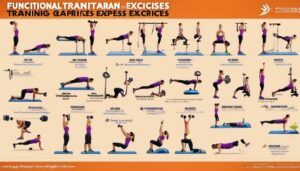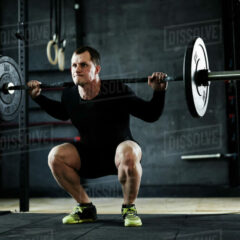
I understand functional training as fitness training that prepares the body for real-life movements and activities. It’s a training style that helps you perform day-to-day tasks more efficiently and with less risk of injury.
This approach goes beyond sculpting a physique or aiming for personal bests in weightlifting. It’s about enhancing your natural movement patterns and improving your body’s function in various planes of motion.
When you engage in functional training, you might notice an increase in balance and coordination, an improvement in posture, and a decrease in the everyday aches and pains that stem from repetitive or sedentary lifestyles.
How does this differ from other exercise regimens? Unlike traditional bodybuilding, which isolates specific muscles, functional training focuses on full-body movements using multiple muscle groups simultaneously.
While bodybuilding might increase muscle size, you need to note that functional training prioritizes strength, conditioning, and agility applicable to your daily life.
But enough about the concept—let’s move forward. The following section will dive into the core components that make functional training effective. You’ll learn about essential principles such as stability, mobility, strength, and endurance and how they play a pivotal role in the execution and benefits of functional exercises.
The Core Components of Functional Training
In fitness, functional training takes a distinctive approach, focusing on preparing your body for daily tasks and challenges. Unlike workouts that emphasize only aesthetics or lifting the heaviest weights, functional training has multifaceted benefits, reinforcing the skills and abilities you use daily. This section unpacks the core components at the heart of functional training.
First, stability is the cornerstone of functional movement. It encompasses not just the ability of your muscles to sustain you through exercises but also ensuring that your joints can maintain alignment under varying degrees of movement and stress. Often, stability training uses exercises like planks and single-leg moves to simulate daily activities.
Mobility goes hand-in-hand with stability. It’s about the freedom of your joints to move through a complete range of motion. This critical component affects how efficiently you can perform simple and complex movements. Exercises like lunges and arm circles can greatly enhance joint mobility.
Strength in functional training differs from traditional lifting weights. It isn’t just about how much you can bench press; it’s about improving the force your entire body can generate while performing practical movements. Think squats, deadlifts, and push-ups – exercises that simultaneously strengthen multiple muscle groups and mirror real-world activities.
Endurance, the final component, is about training your body to handle sustained activity over time. It doesn’t just relate to cardiovascular endurance – which is undoubtedly important – but also muscular endurance. Drills that combine elements like walking lunges with overhead presses exemplify how functional training builds this stamina.
These foundational elements incorporate compound movements that engage multiple joints and muscle groups simultaneously. Unlike isolation exercises that hone in on one muscle or group at a time, functional training’s integrated approach provides a more holistic workout that mirrors the complexities of daily life movements.
Custom tailoring functional training to meet individual needs is essential. Your age, occupation, health conditions, and athletic goals should inform the design of your program. A bespoke regimen that acknowledges your unique situation will often yield the best outcomes regarding functional strength and overall fitness.
With an understanding of these core components, you’re ready to explore many exercises that make up a functional training regimen. From tools like kettlebells and resistance bands to good old gravity and your body weight, the next section will guide you through setting up your personalized functional training toolkit.
Your Functional Training Exercise Toolkit
When I gear up for functional training, I always think about the core exercises that serve as my toolkit. These moves enhance my performance and come in handy for daily activities. Let’s get into specifics.
Squats are my starting point. They’re a powerhouse for leg strength and stabilize the core. Whether hoisting groceries or standing up from my chair, I feel the benefits.
Next, I swear by lunges. They offer balance and help me move better in any direction. Lunges give me confidence when taking the stairs two at a time or chasing after my runaway dog in the park.
Push-ups come third. I do them for upper body and core stability. Often underrated, push-ups make tasks like pushing a heavy door feel like a breeze.
I also need to look into deadlifts. They’re about lifting with your legs, not your back, which is crucial for safe lifting techniques in everyday life.
Now, kettlebell swings are a game-changer for fitness buffs who want to up the ante. They work multiple muscles and get the heart pumping.
Battle ropes might look intimidating, but they’re fantastic for building endurance. They simulate a lot of arm-intensive activities and give me that extra edge.
I’ve also grown fond of using medicine balls for explosive power, especially with throw-and-catch exercises that mimic real-world movements.
Of course, you might only sometimes have access to equipment. Planks, burpees, and mountain climbers are my go-to’s, requiring only a little floor space.
Regardless of the exercises I choose, modification is critical. I always tailor them to fit my fitness level and goals, stepping up or dialing back as needed.
Building a functional toolkit is one thing; consistency is another. I’ll talk about sticking to the routine and seamlessly integrating functional training into life. Stay ready for practical tips on creating a routine you’ll stick with.
Creating a Functional Training Routine That Lasts
Sustainability is the key to making any fitness program effective over the long term. When you venture into functional training, the goal is to weave these exercises smoothly into your weekly routine, so they become as habitual as your morning coffee.
Everyone’s life is unique, so a one-size-fits-all approach doesn’t work. Whether you’re a busy parent with pockets of time or a professional with a more structured schedule, functional training can flex to fit your needs. It’s not just about the hours you set aside each week; it’s about integrating the movements into your daily life.
Let me emphasize that consistency is pivotal. Your body adapts to the demands you regularly place on it. By consistently performing functional exercises, you’re teaching your muscles to work seamlessly together, improving performance in everyday activities.
Tracking your progress plays a two-fold role. Firstly, it gives you a clear picture of where you started and how far you’ve come – nothing fuels motivation more than seeing your growth. Secondly, it can guide you in tweaking your workout plan to address any lingering weak spots.
Attending workshops, engaging with online communities, or hiring a personal trainer can provide invaluable insights. These resources can help correct your form, introduce you to new exercises, and keep your routine fresh and engaging.
By staying disciplined, open to learning, and responsive to your body’s needs, you’re setting the stage for a healthier, more active future.

Thanks for breaking down the core components of functional training! I’ve been curious about incorporating it into my routine, especially considering the emphasis on real-life movements. I love the idea of enhancing daily activities. For those who have been doing functional training, what specific exercises have made the most significant impact on your daily life? I’m eager to hear personal experiences and recommendations! Thanks again!